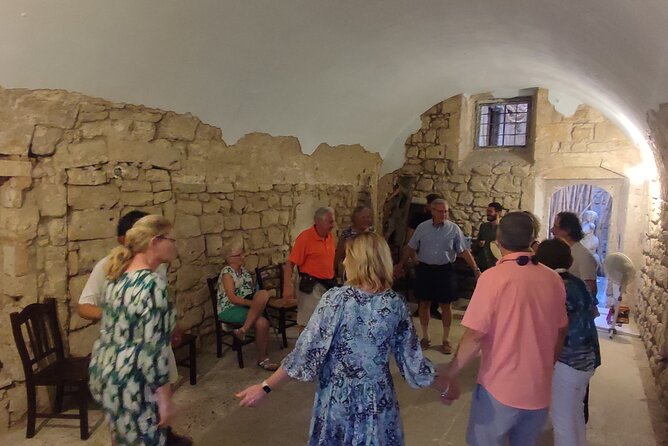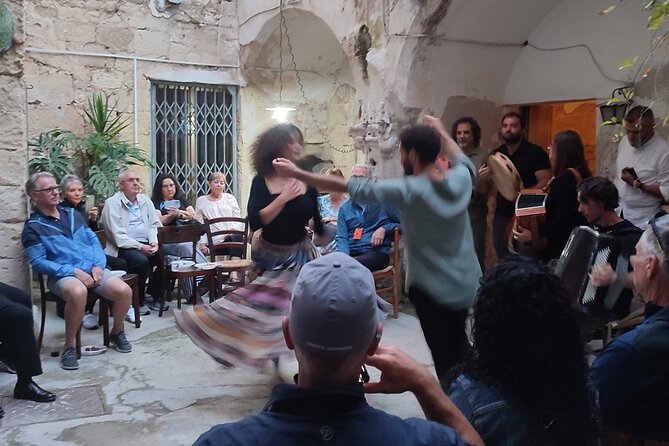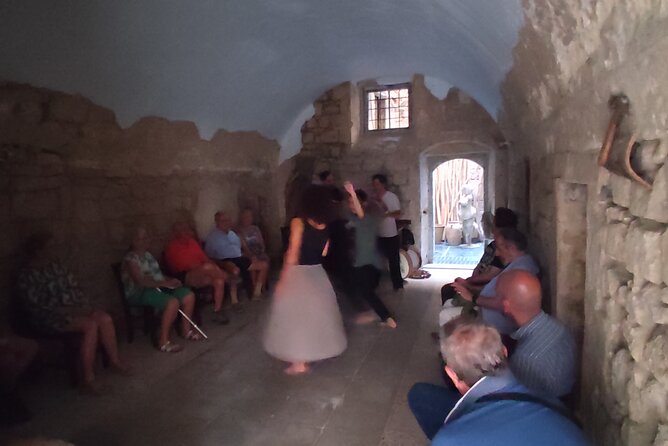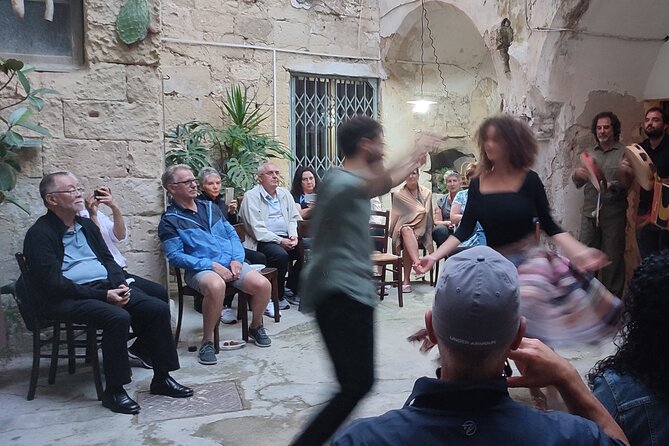Typical Salento Dance: Pizzica & Tasting.
In the heart of Salento, a dance form so infectious and lively thrives that it seems to pulse with the very essence of the region’s soul.
The Pizzica dance, with its captivating rhythms and spirited movements, is more than just a dance; it’s a cultural phenomenon that ignites a passion in all who witness it.
But what happens when this mesmerizing dance intertwines with the tantalizing flavors of Salento’s cuisine?
The fusion of Pizzica and tasting sessions creates an experience that transcends mere entertainment, offering a sensory journey that immerses participants in the vibrant tapestry of Salento’s traditions and tastes.
Key Points

- Pizzica dance embodies Salento’s cultural identity and history.
- Traditional music instruments like tambourine and organetto accompany lively melodies.
- Festivals celebrate Pizzica with energetic movements and community bonding.
- Salento cuisine offers a blend of Mediterranean flavors paired with local wines.
Brief History of Pizzica Dance
The evolution of the Pizzica dance traces back to centuries-old traditions deeply rooted in the folklore of the Salento region in Italy. Pizzica finds its origins in the rural areas of Salento, where it was believed to have healing powers. This traditional dance was thought to cure the bite of a tarantula, hence the name ‘Tarantella.’
The dance is characterized by its fast-paced movements and energetic music, reflecting the vibrant spirit of the local culture. Pizzica isn’t merely a form of entertainment but a representation of community bonding and celebration of life. Over time, this dance has evolved into a symbol of cultural identity for the people of Salento, preserving the rich folklore traditions of the region.
Traditional Pizzica Music Instruments

Exploring the vibrant world of traditional Pizzica music reveals an array of unique instruments that form the rhythmic backbone of this captivating dance form. These traditional instruments are deeply rooted in folklore music and add a rich layer of authenticity to the Pizzica experience. Here is a glimpse of some of the key instruments used in traditional Pizzica music:
| Instrument | Description | Role in Music |
|---|---|---|
| Tambourine | Circular frame drum with pairs of jingles | Provides rhythmic accompaniment |
| Launeddas | Triplepipe woodwind instrument | Produces melodic tunes |
| Organetto | Hand-operated bellows-driven accordion | Adds harmony and depth to the music |
These instruments blend together harmoniously, creating the lively and dynamic melodies that define the traditional Pizzica sound.
Steps and Movements in Pizzica Dance

Delving into the heart of Pizzica dance, one can experience the intricate steps and movements that weave a tapestry of storytelling through rhythmic expression. Traditional dances in Salento are deeply rooted in folklore traditions, and the Pizzica dance is no exception. Here are some key elements of the steps and movements in Pizzica:
-
Tarantella-like Movements: Pizzica is characterized by fast-paced movements reminiscent of the tarantella, with quick spins and footwork that mirror the intensity of the music.
-
Partner Interaction: Participants often engage in partner dances, where synchronized steps and gestures create a lively and dynamic performance that celebrates the connection between dancers.
-
Expressive Gestures: Dancers use expressive arm movements and gestures to convey emotions and narratives, adding depth and richness to the overall performance.
Pizzica Dance Festivals in Salento

Dive into the vibrant world of Pizzica Dance Festivals in Salento, where traditional music and lively performances come together to celebrate the rich cultural heritage of the region.
These festivals are deeply rooted in local traditions, serving as a platform to honor the history and customs of Salento. The Pizzica dance, with its energetic movements and infectious rhythm, takes center stage, captivating both locals and visitors alike.
These events hold great cultural significance, acting as a way to preserve and promote the unique heritage of the area. Attendees can enjoy the spirited atmosphere, partaking in the age-old tradition of Pizzica dancing while experiencing the essence of Salento’s rich cultural tapestry.
Salento Cuisine and Wine Tasting

Enjoy the flavors of Salento through a culinary journey that combines traditional dishes with exquisite local wines, highlighting the region’s rich gastronomic heritage. Salento culinary delights offer a unique blend of Mediterranean influences with fresh seafood, olive oil, and aromatic herbs.
To enhance the dining experience, consider these wine pairing suggestions:
-
Primitivo Wine: Pair this robust red wine with hearty meat dishes like Orecchiette alle Cime di Rapa, a local pasta specialty with turnip greens.
-
Negroamaro Wine: This velvety red wine complements dishes such as Pasticciotto Leccese, a flaky pastry filled with custard.
-
Vermentino Wine: Enjoy this crisp white wine with Fritto Misto di Mare, a mixed seafood platter showcasing the region’s coastal bounty.
Common questions
What Is the Significance of the Costumes Worn During Pizzica Dance Performances?
Costumes worn during pizzica dance performances hold deep significance. They reflect Salento’s rich tradition, with intricate designs symbolizing history and culture. Learning about these traditional outfits enhances one’s understanding of the dance’s roots and authenticity.
Are There Any Specific Rituals or Traditions Associated With Learning and Performing Pizzica Dance?
In learning and performing the pizzica dance, individuals embrace ritualistic movements that intertwine with traditional music. These rituals symbolize cultural heritage and storytelling, creating a mesmerizing experience that connects participants to the rich history of the dance.
How Has the Modern Interpretation of Pizzica Dance Evolved Compared to Its Traditional Roots?
The modern interpretation of pizzica dance has evolved by infusing contemporary elements while honoring its traditional roots. This evolution reflects a dynamic blend of new styles and movements, keeping the essence of the dance alive and vibrant.
Are There Any Famous Pizzica Dance Groups or Performers That Tourists Should Look Out for in Salento?
Famous performers in Salento, such as Canzoniere Grecanico Salentino, and I Tamburellisti di Otranto, offer captivating pizzica dance workshops for travelers. These renowned groups infuse energy and tradition, providing an authentic cultural experience in Salento.
Can Visitors Participate in Pizzica Dance Workshops or Classes During Their Stay in Salento?
Visitors can enjoy Salento’s vibrant culture by participating in dance workshops. Pizzica lessons offer an authentic experience, connecting travelers to local traditions. These cultural activities provide a hands-on way to engage with the region’s rich heritage.
Last Words
Enjoy the rhythmic beats of the Pizzica dance and savor the authentic flavors of Salento through a unique cultural experience that combines music, dance, and food.
From the history of Pizzica to the traditional instruments used, this article has provided a glimpse into the vibrant world of Salento’s heritage.
Don’t miss the opportunity to dance, taste, and celebrate the rich cultural tapestry of this enchanting region.